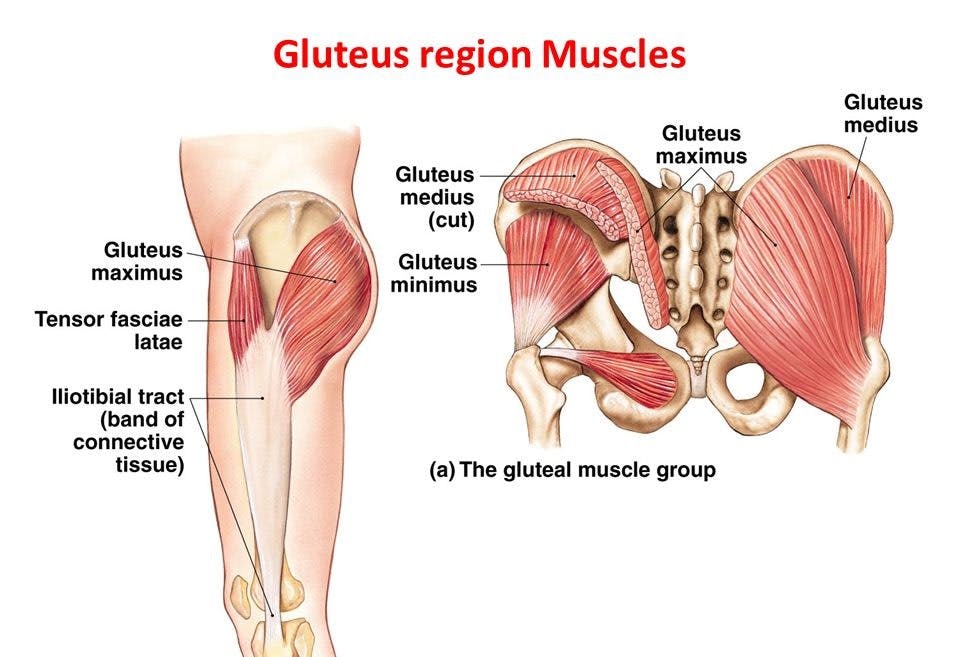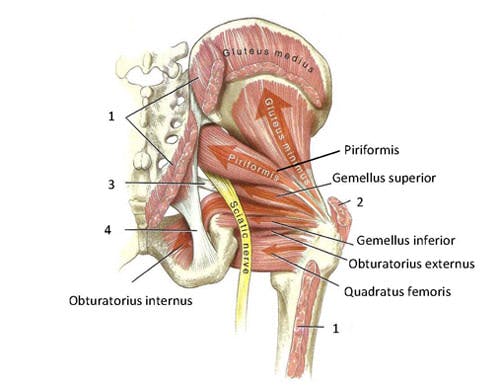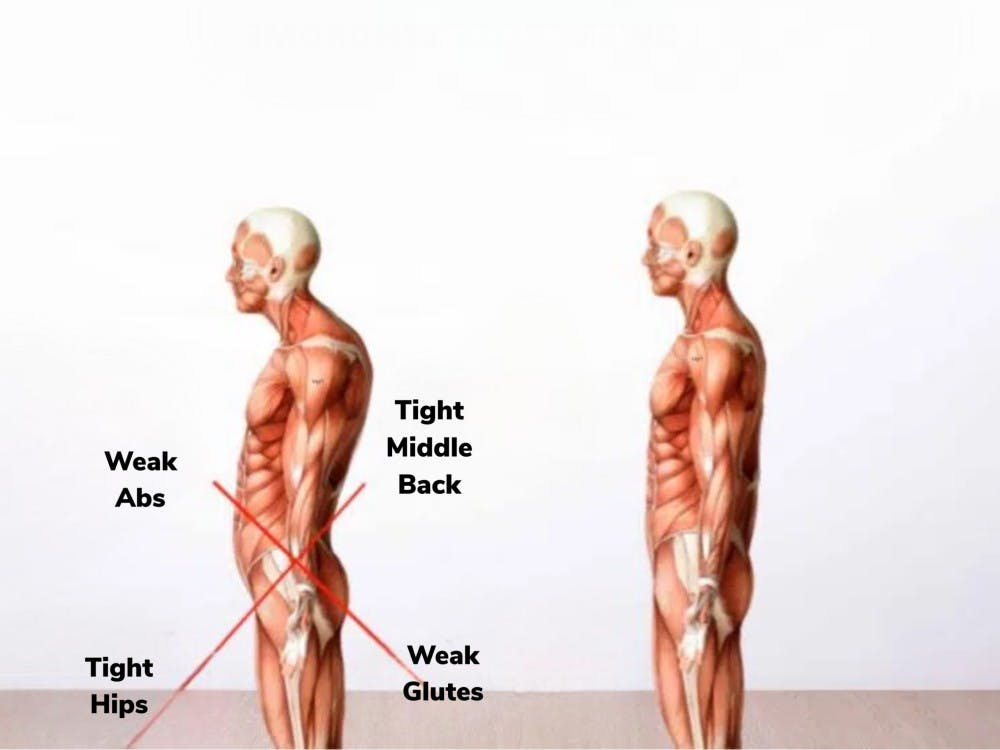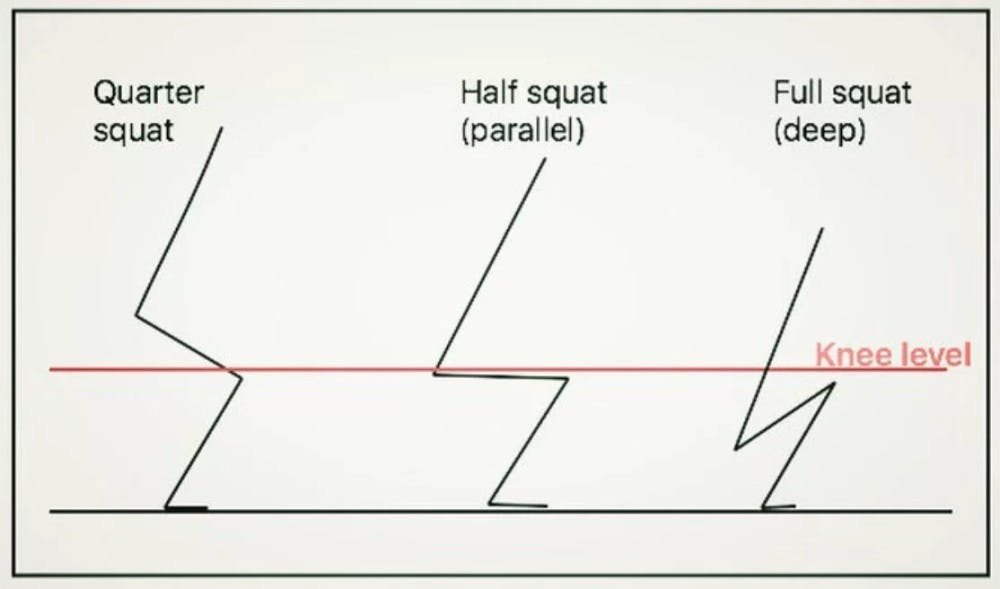How to Fix Tight Hips & Glutes When You Sit All Day
Our content strives to support, inform, and motivate you to meet your health goals. We want to be your trusted source of expert- and science-backed info dispensed in simple, actionable ways. Read our Editorial Guidelines.
If you’re like so many of us who’ve been forced to work from home in these last few years, I’m sure you’ve experienced some challenges along the way on your fitness journey. Even for those going back to work in the office, we all share similar hurdles with our health.
None of us are surprised that sedentary habits have negative effects on us, like breathing heavily when going up a flight of stairs or feeling our backs and bottoms stiff and sore.
A part of that tightness are your glutes telling you to get up!
The glutes are one of the anchors that holds our bodies up. They help us walk, sit and stand, go up and down stairs, and keep our spines straight.
Here, you’ll learn about the muscles that make up your glutes and the motions they’re responsible for. We’ll go over how they get tight or stiff in the first place and how that can impact you.
TL;DR: There are more muscles in your bottom than you think. The easiest way to relieve any glute stiffness or soreness is to walk around, no matter if you sit or stand all day. Just move. Do it every 30 minutes if you can. If you can’t, scroll down to the bottom of the article for some easy activities you can do at your workstation.
Gluteal Complex: What’s Inside
The three separate glute muscles that most people are familiar with:
Gluteus maximus
Gluteus medius
Gluteus minimus

The glute max is the largest of the three and covers the other two. But, there is a fourth muscle that is commonly associated as part of the superficial group of gluteal muscles: the tensor fascia latae (TFL). The TFL is a small muscle that blends into the glute max and into the iliotibial tract, also known as your IT band.
Underneath these four superficial muscles are the deeper gluteal muscles:
Piriformis
Gemellus superior and inferior
Obturator internus and externus

All together, these muscles make up the “gluteal complex.”
Function of the Gluteal Complex
When we think of the glutes, it’s easier and more functional to think of them as the gluteal complex. Since there are superficial and deep muscles, they all work together to perform the same motions. Some muscles participate more than others depending on the movement, but overall, they work with one another.
Functions of the gluteal muscles include:
Hip extension
Examples: Stand up straight or kick your leg back
Hip external and internal rotation
External rotation example: Cross your leg while sitting down
Internal rotation example: Turn your foot inward while you walk
Hip abduction
Example: Opening your knees while sitting
Why Your Glutes Can Feel Tight
First, let’s talk about injuries. There are a ton of nerves and blood vessels that run inside and in between the different layers of the superficial and deep muscles.
Common injuries can include:
Nerve impingement, which can feel like pins and needles on the back or front of your thigh. If it’s really bad, it can run down to your foot or ankle. There can also be “electric” type of pain.
IT band syndrome, which can start along the side of your thigh and run down to the side of your knee. This usually gets worse with activity and can be common in runners.
Bursitis, which can be pain and tenderness along the side of the hip that worsens with walking or running.
This isn’t an exhaustive list and shouldn’t be used as a diagnostic tool. If you experience some of the above symptoms, visit a medical professional who can diagnose you properly.
Muscle tightness or stiffness can occur for a variety of reasons. These are the most common:
Exercise
Muscle knots, otherwise known as myofascial trigger points
Anatomically shortened or elongated muscle
Infection
Chronic disease
Anxiety or stress
Exercise is a huge source of soreness and stiffness. You work your muscles hard and afterwards they can be achy or even painful. Check out our article on delayed onset muscle soreness (DOMS) if you want to know more about how to deal with post-exercise soreness.
Working out, underlying infection, chronic disease, and stress can result in the development of muscle knots, or trigger points. These knots form from repeated irritation of a muscle. For fitness enthusiasts, that can mean performing similar exercises that hit the same set of muscles week in and week out. But, trigger points can occur in anyone who sits too long at the computer, looks down too long at their phone, or drives for long distances. We’ve all felt that knot in our necks or our backs.
Occasionally, some of us are born with or develop muscles in our infancy that have impaired length, whether too short or too long. This variation in length can cause joint stiffness or joint laxity from an early age that can persist into adulthood.
A licensed medical professional can perform manual tests to see if you have a true limitation in your range of motion because of a congenital or developmental issue.
Most of the time, muscle tightness isn’t a result of an anatomical abnormality, but rather, a matter of habit. If you consider how the muscles of the gluteal complex move naturally — hip extension as well as internal and external rotation and abduction — you can see how performing the opposite actions for prolonged periods of time can shorten one set of muscles and lengthen others over time.
An example: sitting all day, every day. In this position, your glutes are lengthened because your hips are flexed. Have you ever stood up after sitting down for a long time and felt the front of your hips feeling “tight?” Well, that’s because they were shortened that entire time. By the same token, you might stand up and feel your low back and glutes feeling “stiff.”
It’s two sides of the same coin.
Here’s another one. Do you tend to cross one leg over the other more often when you sit? Have you ever tried to switch and cross the other leg over, then realized that one side is just tighter than the other? That’s another example of a habitual change that results in one side of your gluteal complex shortening while the other side lengthens.
But, I can’t stress this enough: to shorten or lengthen a muscle permanently takes a lot of time. It doesn’t happen over a couple of hours and days. This takes weeks, months, and years of the same habit done daily.
3 Easy Ways to Prevent Tight Glutes
The solution for gluteal and hip tightness appears simple. In a very general sense, just move. Avoid sedentary behavior for myriad reasons, but we’re focusing strictly on muscular implications.
If sitting for a long time lengthens the gluteal muscles, then standing does the opposite — it shortens them.
When we stand with stooped shoulders and rounded lower backs, we place the glutes in a shortened position. This prevents them from creating as much force when contracted, essentially weakening them. This can lead to a harder time stretching them, and more complaints of stiffness.

To manage this, get out of that chair and stretch or take a walk around your house or office.
If you stand for too long, sit for a little while or take a walk around your work area. Make it simple to remember and move every 30 minutes. Set an alarm on your phone if that makes it easier, especially in the beginning when you’re first building the new habit.
Walking is an easy solution because the simple act of taking steps will move your glutes through a part of their range of motion, essentially keeping them “loose.”
If you can’t leave your work area for whatever reason, then simply stand up and sit down in your chair a few times. This forces your glutes to work too.
If you don’t have a chair, do some air squats in place. This simulates the act of sitting and standing. You don’t have to do full squats; even squatting halfway or a quarter of the way down serves a similar purpose.
Does Stretching Help Loosen Tight Muscles?
I’ve given you ideas on how to change a habit that may cause glute stiffness, but what do you do if you already have it?
Most people stretch to lengthen the muscles. Stretching can and should be a part of your warm-up or cooldown routines before or after workouts.
Two broad categories of stretching include:
Static: This type of stretching increases the very end of a specific range of motion with the goal of progressively lengthening a group of muscles. Think getting better at doing a split. You would hang out at the very end range of a split and slowly increase that range over a period of time.
2. Dynamic: This type of stretching involves moving your muscles’ available active range of motion. In this case, you aren’t trying to increase your maximum range of motion. Instead, you’re “greasing the wheel” of the motion that you already have.
There’s a time and place for both of these kinds of stretches.
Generally speaking, before you perform an activity, dynamic stretching is the gold standard. However, there are some benefits to doing static stretching if you keep it to under 60 seconds, which would be considered “short-duration” static stretching.
If it makes it easier for you, do dynamic and short-duration static stretching as part of your warm-up and then long-duration static stretching (longer than 60 seconds per position) for your cooldown.
The goal of static stretching is to go past the maximum range of motion that you have at a particular joint. If you have a sufficient active range of motion already, then there’s really no need to gain more unless you have a specific goal in mind, such as those splits I mentioned earlier.
Exercises and Stretches
We’ve already gone over what motions the gluteal muscles are responsible for; now let’s discuss the exercises that leverage those motions and help reduce stiffness.
Air Squats

Air squats, aka bodyweight squats, means you don’t add weight and there’s no place for you to sit down. As you can see from the diagram, you can choose any depth you feel comfortable doing.
To decrease glute stiffness, quarter- and half-squats are all that you really need to do.
Quarter-squats can be performed while standing.
Half-squatting is similar to sitting down in a chair, which makes it ideal for anyone who sits for much of the day.
Internal and external rotation can get tricky, especially with how involved these two movements can be, but these exercises can help.
90/90 Hip Stretch
This is my personal favorite and hits all of the awkward angles that you don’t normally associate with the glutes.
It can take some getting used to and some people may not have enough internal or external rotation to actually touch their knees to the ground. Good news though — you don’t have to! Perform the movement as comfortably as you can within your personal range of motion and it’ll still get the job done.
Sitting Cross Legged
This dynamic stretch can be done almost anywhere: on the couch, at your desk, in the break room. Wherever you want.
The key here is slow and controlled movement up and down, using your muscles to move through the range.
Pushing your knee down would be abduction and external rotation, and moving your knee up would be the opposite motions.
Cross Legged Twists
Do this one right after the Sitting Cross Legged stretch.
Don’t over-rotate. Move through that range in a calm and controlled manner.
This one doesn’t hit the glutes as directly as the one above, but you’ll still benefit from it.